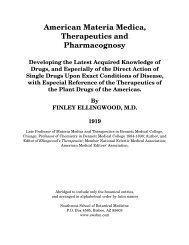SCARLET FEVER. Synonyms.—Scarlatina; Scarlet Rash. Definition ...
SCARLET FEVER. Synonyms.—Scarlatina; Scarlet Rash. Definition ...
SCARLET FEVER. Synonyms.—Scarlatina; Scarlet Rash. Definition ...
You also want an ePaper? Increase the reach of your titles
YUMPU automatically turns print PDFs into web optimized ePapers that Google loves.
diphtheria. The deeper tissues become infiltrated, and a foul phagedenic<br />
ulceration is seen. The nares becomes involved, and an acrid secretion is<br />
discharged.<br />
As the sepsis increases, a cellulitis develops, the cervical glands enlarge,<br />
the neck becomes greatly swollen, extending in some cases beyond the<br />
ears. The eyes are glued together with a brownish secretion, while the<br />
ears discharge the same characteristic material. The system seems to<br />
have more of the poison than it can carry, and the overflow escapes by<br />
way of the orifices.<br />
The cervical glands suppurate, and a disgusting, pultaceous abscess is<br />
the result. The extremities become cold, the pulse is small, weak, and<br />
rapid, the mind is dull, coma comes on, and the child dies from toxemia.<br />
The eruption, when it makes its appearance, is of a dull, dusky red color.<br />
Sometimes it appears as petechise, which, enlarging, form ecchymotic<br />
patches. At other times it appears the second or third day, only to<br />
remain a few hours, when there is a retrocession of the eruption.<br />
Desquamation.—From six to ten days after the eruption first makes<br />
its appearance, desquamation begins. The eruption fades, the skin<br />
becomes dry and constricted and is shed in the form of dry, bran-like<br />
scales. Sometimes it comes off in large flakes or even in ribbon-like strips<br />
a foot or more in length, and in rare cases, where the epidermis is thick,<br />
like on the hand or foot, a complete cast of the member is shed.<br />
Desquamation lasts from ten days to ten weeks.<br />
Complications.—In scarlet fever, diphtheria, measles, and influenza,<br />
the middle ear is often affected by extension through the Eustachian<br />
tubes and the process may also affect the labyrinth.<br />
In quite a number of cases the labyrinth is affected directly by the<br />
systemic poison, the middle ear escaping any morbid inflammation<br />
whatever. (Foltz.)<br />
Respiratory Apparatus.—The inflammation may pass from the throat to<br />
adjacent parts of the respiratory apparatus, and bronchitis or bronchopenumonia<br />
may render the disease still more serious. Nephritis is a very<br />
common complication, though more frequently it is one of the sequelae.<br />
The Eclectic Practice of Medicine - PART I - Infectious Diseases - Page 131

















